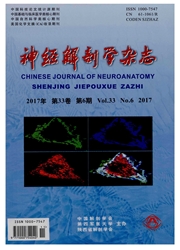

 中文摘要:
中文摘要:
目的:探讨槲皮素(Quercetin,Qu)对大鼠缺氧损伤后少突胶质前体细胞(oligodendrocyte precursor cells,OPCs)增殖的作用。方法:取新生1~2 d Sprague-Dawley(SD)大鼠大脑皮质细胞进行原代培养,振荡分离后纯化3 d行Olig2和A2B5免疫荧光染色鉴定。纯化的细胞分为正常对照组、模型组(缺氧9 h)和Qu处理组(3,9,27,81μmol/L)。缺氧后3 d光镜下观察细胞形态学变化,CCK-8法检测细胞存活率,Olig2免疫荧光染色计数阳性细胞数。结果:纯化培养3 d的细胞胞体呈圆形,有双极或三极突起。免疫荧光染色显示,绝大部分细胞为A2B5和Olig2阳性,A2B5/DAPI阳性细胞率为98.54%。缺氧9 h后,模型组很多细胞出现突起皱缩或崩解,细胞密度较Qu处理组明显降低;培养至3 d,光镜下计数和CCK-8检测结果均表明9μmol/L和27μmol/L Qu处理组细胞数较模型组显著增加(P〈0.01,P〈0.05);Olig2免疫细胞化学染色结果进一步表明9μmol/L和27μmol/L Qu处理组OPCs数较模型组显著增加(P〈0.01,P〈0.05)。结论:9μmol/L和27μmol/L Qu有促进缺氧损伤OPCs增殖的作用。
 英文摘要:
英文摘要:
Objective:To observe the effects of quercertin(Qu) on the proliferation of oligodendrocyte precursor cells(OPCs) after hypoxia injury.Methods: The primary cultured cells from cerebral cortex of Sprague-Dawley rats on postnatal days 1-2 were purified by orbital shaker and differential adhesion,and were identified through immunofluorescence staining for Olig2 and A2B5 three days after purification.The purified cells were divided into control,model(9 hours ' hypoxia exposure) and Qu treatment(3,9,27,81 μmol/L and hypoxia exposure) groups.Three days after hypoxic injury,cell morphology was observed under light microscope and the cell survival rate was detected by Cell Counting Kit-8(CCK-8) assay.OPCs was counted by immunofluorescent staining of Olig2.Results: The purified cells were oval shaped with bipolar or tri-polar processes.Immunofluorescence demonstrated that the majority of these cells were Olig2-and A2B5-positive,and the ratio of A2B5/DAPI was 98.54% three days after purification.After 9 hours ' hypoxia,the processes of most cells shrank or disintegrated and the cell density was significantly decreased in model group compared with Qu-treated group.Three days of culture post 9-hour hypoxia showed the cell number in 9 μmol/L and 27 μmol/L Qu-treat groups were significantly increased compared to the model group(P0.01,P0.05) as revealed with light microscopy and CCK-8 assay.Further study showed that the number of Olig2-positive OPCs in 9 μmol/L and 27 μmol/L Qu-treated groups were significantly increased compared with the model group(P0.01,P0.05).Conclusion: Treatment with Qu(9,27 μmol/L) could promote the proliferation of OPCs after hypoxia injury.
 同期刊论文项目
同期刊论文项目
 同项目期刊论文
同项目期刊论文
 期刊信息
期刊信息
